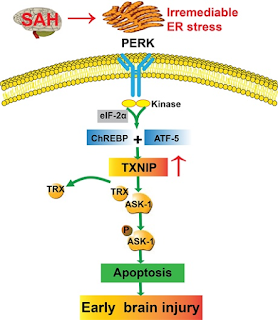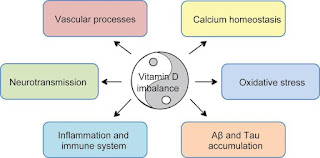Early Brain Injury
Early Brain Injury (EBI) is a recent concept that looks at overall brain injury after Subarachnoid Haemorrhage (SAH) There have been a number of recent articles indicating that the pathophysiologic consequences of an aneurysmal SAH lead not only to vasospasm but also to a global ischemic injury to the brain. This is a significant move away from the previous theories of vasospasm as being the main consequence of SAH, leading to neurologic deficits. Furthermore, it should be pointed out that EBI may be the primary cause of mortality in SAH patients. Therefore, it seems that EBI should be considered a primary target for future research.
EBI occurs as a result of the impact of an aneurysmal SAH on the brain. A number of key factors occur, including elevation of intracranial pressure, reduction of cerebral blood flow, suppression of cerebral perfusion pressure, fall in brain oxygenation, blood-brain barrier breakdown, brain oedema, and neuronal cell death. For an in-depth review of the pathogenesis of EBI in relation to SAH. The mechanisms behind many of these key events are poorly understood, and there are currently no treatment options available by which they can be prevented or treated. Although these factors have long been understood, their effects and consequences are not. Indeed, many of these factors are presumed to occur in the clinical setting but in fact have only ever been demonstrated in animal models. There are currently a number of pathways that have been implicated in EBI. These include the apoptotic pathways, inflammatory pathways, and ischemic pathways, to name but a few. In addition, all of these pathways have 1 common outcome, which is cell death. This can lead to blood-brain barrier breakdown and subsequent oedema or directly to neuronal cell death. Apoptosis has been shown to be an important intracellular pathway leading to cell death, and inhibition of p53-modulated apoptosis has been shown to have favourable effects on mortality and outcome in animal models. Autopsy studies have demonstrated evidence of both apoptosis in the vasculature and cortical infarctions, which can occur in areas remote from the artery that bled. Demonstrated cortical spreading depression in both animal models and patients with SAH. Furthermore, animal studies that included the use of hyperbaric oxygen to counteract the effects of cortical spreading depression have been favourable. proposed an inflammatory aetiology for vasospasm, and this concept has been taken on by others.




Comments
Post a Comment